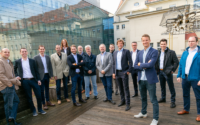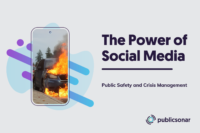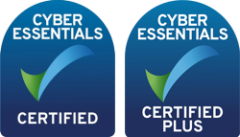Om de verspreiding van het coronavirus tegen te gaan heeft de Nederlandse regering sinds 13 oktober de gedeeltelijke lockdown verzwaard. Voor de volgende vier weken blijven we in het ‘nieuwe normaal’ leven. We geloven in het strikt naleven van de overheidsmaatregelen. We raden iedereen om op de hoogte te blijven door het lezen van de overheidswebsite.




De 1,5 meter afstand regeling is sinds maart 2020 een belangrijk onderdeel van ons dagelijks leven geworden. Terwijl er een afname in fysieke sociale interactie is zien we dat burgers online actiever zijn dan ooit. Vanwege onze passie in open data en het aansturen van crisisbesluitvorming hebben we besloten om dieper in het onderwerp te duiken. Dus vroegen we onze CEO Sjors de vraag: “Hoe besturen we de 1,5 meter samenleving?”.
Luister hier naar de podcast of lees de samenvatting hieronder.
Hi Sjors, thanks for accepting this interview. Interesting times we live in. Firstly, how are you? How are you coping with this situation, whilst having a newborn and being a CEO of PublicSonar?
Thanks. Always nice to share your thoughts on the relevant topics. These are indeed interesting times. First of all, I think it’s perfect timing to get a newborn because there’s nothing that I have to miss because I’m stuck at home with my lovely baby. I think like every manager out there, there were some concerns about how effective will people be, will they be healthy, will they enjoy themselves working from home? And it’s interesting to see that a lot of those worries were not based on anything, because you could see that the team is happy, efficient and business is continuing like ever before.How long have you been with PublicSonar? What is one highlight of your job? What keeps you doing what you do?
Well, I started the car almost six years ago. Back then we were a company with around five people. And since then we’ve grown to almost twenty five people. I always started with the commercial side and that means that I worked a lot with clients. I love to be in touch with clients, understand what drives them, their information position and see how we as a tool, but also as a company can help them with that and be a partner instead of a supplier. Now in the role of CEO, I still have that and that is still what drives me every day. We’ve grown five times so we’re now with twenty five people but we’re still an entrepreneur. We’re still a young company, fresh company where people can take responsibility, where people can take their own initiatives, where we try to jump on opportunities if we see them.
Can you elaborate on your experience with informing decision making from open data?
Yes, certainly. So our goal is to provide the best type of information at the point of decision making. What is always a struggle during a crisis is that the earlier you take a decision, the more options you have. But at the same moment, it takes a long time to build up a strong information position. If you wait very long, you know more. But the opportunities you have to make a decision are way less. Publicly available information is a really valuable source with a lot of information and it’s really fast. So we always mention ourselves, the eyes and ears on the street. I think open data is a really rich source of improving your information position.What is the added value of publicly available information compared to other sources?
Well, I think it’s really dynamic. So what’s interesting about publicly available information is that as soon as something pops up, you see that the public starts talking about it. And that can have an effect on your business. Knowing what that effect is not from sensors, but from what is going on the street is measuring the impact. An interesting example is that for a company in the North of the Netherlands, we are detecting earthquakes. You have sensors for detecting earthquakes, so they know within a couple of seconds that something is going on. However, what we do with monitoring open data is that we measure the impact of such an earthquake. So how many people feel it? Are people afraid of it or is there any anxiety, other people wounded? And those are things you cannot measure with a sensor. It is the people talking and that gives you the information to drive a decision. So it’s the eyes and ears on the street and the opinion of the people that matter for them for driving a decision.
Taking into account the current pandemic – How can we govern the 1.5 meter society?
I think everybody knows that these are strange times. I think it is really interesting to know what is society thinking, how they are acting, and are they following up measures. From that perspective, open data can be really valuable. It says something about how people look at measure, and how you can better communicate so they better understand it. So it can change the way you decide on the policy, but also how you communicate about it. At the same moment, you also want to know when something is going on and there’s a risky situation. So when there are too many people at a certain location. You want to know as soon as possible so you can act on it. It turns out that. In a lot of situations, open data is the first trigger to identify something, and it’s also a great way of building up a situational awareness around certain locations. Of course, social media can be used for communicating as well. So I think there are a lot of aspects where publicly available information can help drive better decisions, understanding the public better and identifying high risk situations.What are some use cases or interesting examples that you can name where technology can really contribute? So in the case of such a pandemic, what is valuable for decision makers to find online?
Technology is improving really fast. There are a lot of tools online that, for example, measure sentiment. But sentiment is something that is really difficult to measure. However, measuring sentiments in a crowd can be relevant because it drives decisions. If there’s a crowd that has a negative sentiment or a sentiment of fear, you can almost predict what’s going to happen next. We are working on technologies, but you can measure sentiments in a way more advanced by using artificial intelligence.So it’s not working with databases, with negative words and positive words. It’s looking at a full sentence, understanding it and giving you a number of what type of sentiment is living in a crowd. I think that is one of the examples where technology can help you being on top of your decision-making because understanding the crowd sentiment is almost predicting what’s going to happen.
A few months back PublicSonar was described by the EPS for providing the best information at the point of decision-making. What do we do differently?
I’m really proud that such an organisation is recognising us for that. And indeed we do things differently. So it has a couple of components. It has a knowledge component, technology component and a process component. Starting with the technology. When you want to monitor publicly available information, having complex queries that you can utilise in a simple way is key. And with that, you are preventing an overload and make sure you don’t miss anything. That is something we do. The second part is about processes. When you are looking at publicly available information, you need to be aware that you can look at sensitive data. It is information that is coming from the public. So you need to be aware of compliance rules around it. On the one hand, you have the compliance rules that are the laws and regulations such as GDPR. At the same moment, you also have the terms of service of the sources itself. So you cannot use data for anything you want. So we build in compliance controls to help our clients do the monitoring processes in a compliant way. And I think that’s where we make a difference. The third one was about knowledge. I think it’s our niche working with the public sector or on safety, security, infrastructure, mobility. We have been in this segment for over eight or nine years. We worked with a lot of professionals around the topics that they want to monitor. And from that, we gained a lot of knowledge about how they’re using data in their daily operations. So having that knowledge, specialising around these topics, doing data analytics is our USP. You can also see that our artificial intelligence models outperform the ones of Google. That shows that we’re building something unique.What are your aspirations for our technology? Where would you like to see us in the future?
We are currently an entity in the Netherlands. In the safety and security sector, we are the go-to player. However, we want to make sure that all over the world in crisis centers or operational centers, people have the best information at the fingertips to make the best decisions. And I think we can help them with that. So if you ask where we want to be in five years, I hope we will be in a lot of different countries where we can support governments making the best decisions with open data, but probably also with other types of data. I believe that the future is data agnostic and in the end, what we want to achieve is that the world is a little bit better and a little bit safer. And if we can move a little bit in that direction, I’m really happy.






